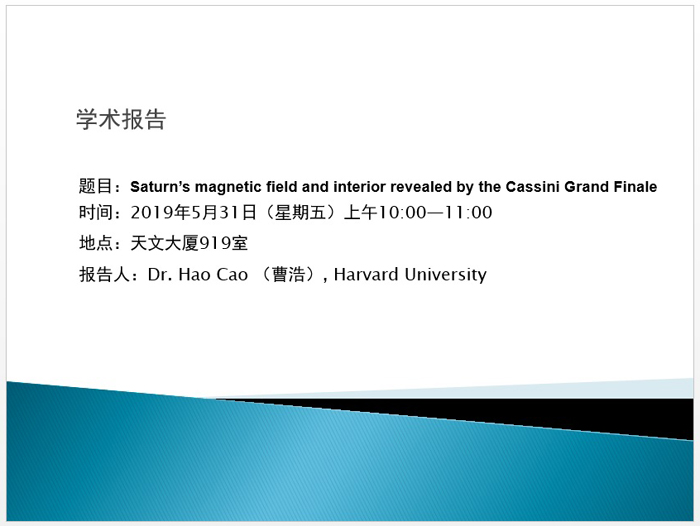Saturn’s magnetic field and interior revealed by the Cassini Grand Finale

摘要: Magnetic fields are windows into planetary interiors. The existence and properties of the planetary magnetic fields reflect the interior structure, dynamics, and evolution of the host planets. Saturn’s magnetic field continues to offer surprises since the first in-situ measurements made during the Pioneer 11 Saturn flyby. The Cassini mission entered the Grand Finale phase in April 2017, during which time the spacecraft dived through the gap between Saturn’s atmosphere and the inner edge of the D-ring 22 times before descending into the deep atmosphere of Saturn on Sep. 15th 2017. The unprecedented proximity to Saturn (reaching ~1440 km above the cloud deck) and the highly inclined nature of the Grand Finale orbits provided an ideal opportunity to decode Saturn’s internal magnetic field and the electromagnetic environment between Saturn and its rings. Here I will report the new features of Saturn’s magnetic field revealed by the Cassini Grand Finale, including a newly discovered low-latitude inter-hemispherical field-aligned current (FAC) system, the directly determined northward offset of Saturn’s magnetic equator and its “longitudinal” variations, small-scale yet highly consistent magnetic structures along the latitudinal direction. Implications on deep zonal flows (differential rotation) and stable stratification inside Saturn will be discussed. In closing, I will highlight the magnetic aspects of the ongoing Juno mission and a few upcoming planetary missions (e.g. Psyche mission to asteroid 16 Psyche, Clipper to Europa, BepiColombo to Mercury, JUICE to Ganymede, and a possible mission to Uranus/Neptune) and how they will help answer questions ranging from the thermal evolution history of asteroid 16 Psyche to the salinity of Europa’s ocean.
Dr. Hao Cao (曹浩) Dr Hao Cao is a Research Associate at the Department of Earth and Planetary Sciences at Harvard University. Prior to joining Harvard University in 2017, Dr Cao spent three years at the California Institute of Technology (Caltech) as a postdoctoral scholar. Dr Cao completed his PhD at the University of California Los Angeles (UCLA) in 2014 and his undergraduate studies at the University of Science and Technology of China (USTC) in 2009. The overarching goal of Dr Cao’s research is to understand the interior structure, dynamics, and evolution of planetary bodies. Dr Cao’s research experience encompasses space magnetometer data analysis and numerical magnetohydrodynamics (MHD) modeling of planetary dynamos. Dr Cao is a Co-Investigator of the JUICE MAG team, a member of the Juno Interior Working Group, a Cassini Participating Scientist, and a member of the Cassini magnetometer (MAG) team.
附件下载:
Speaker:9:30am, August 01th, Tuesday
Time:Yan Gong (Max-Planck-Institute for Radio Astronomy)
Location:Middle conference room, 3rd floor
Speaker:9:30 am July 27th (Thursday)
Time:Junhao Liu (East Asian Observatory)
Location:Middle conference room, 3rd floor
Speaker:Wednesday, July 26th 3:00pm
Time:Dr. Pinghui Huang (黄平辉)
Location:Middle conference room, 3rd floor
Speaker:7月14日,星期五,上午10点
Time:闫大海(云南大学)
Location:1715
Speaker:3:00 pm July 13th (Thursday)
Time:Shuang Zhou (University of Nottingham)
Location:Lecture Hall, 3rd floor
Speaker:1:30 pm July 6th (Thursday)
Time:Prof. Wen-Ping Chen (National Central University)
Location:Lecture Hall, 3rd floor